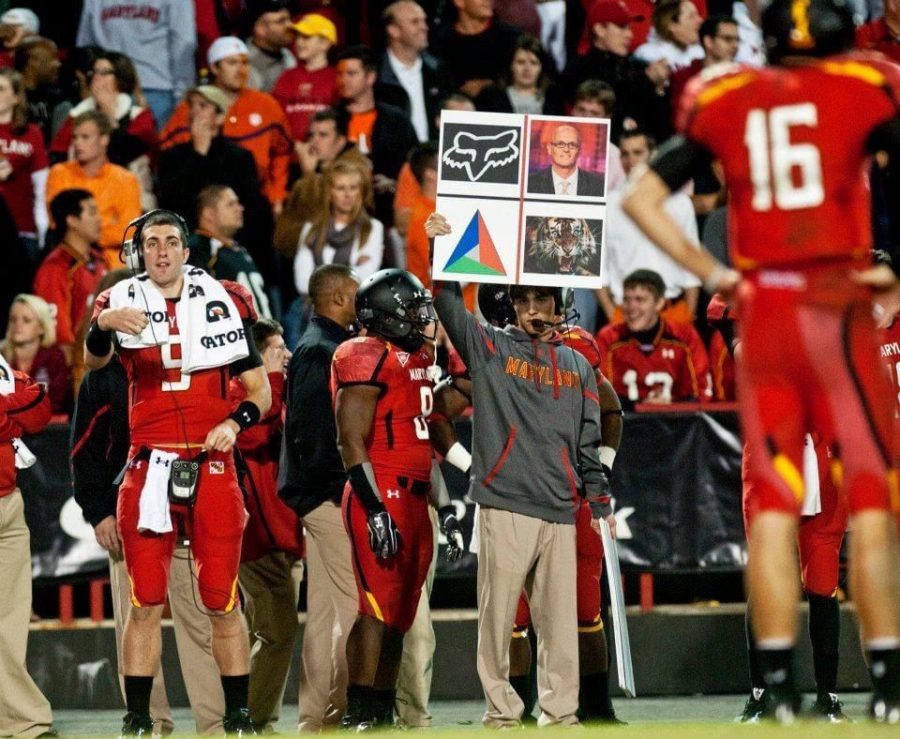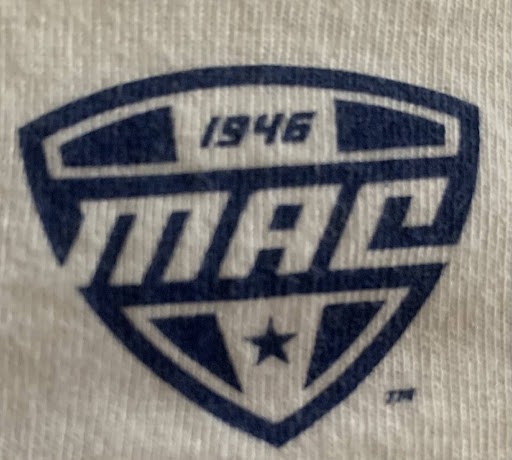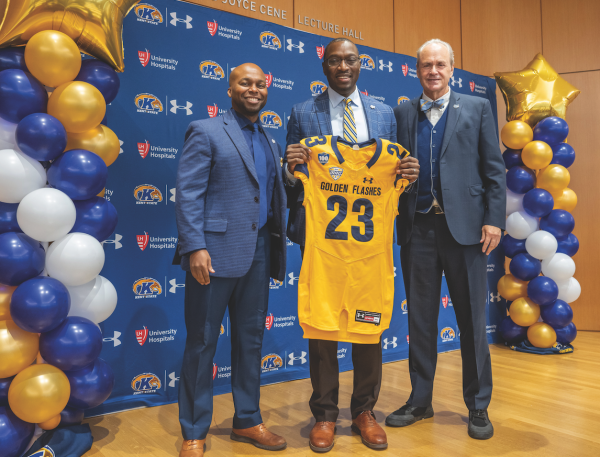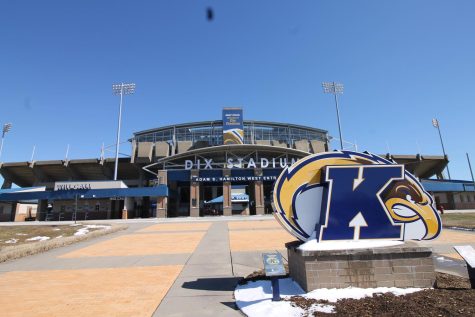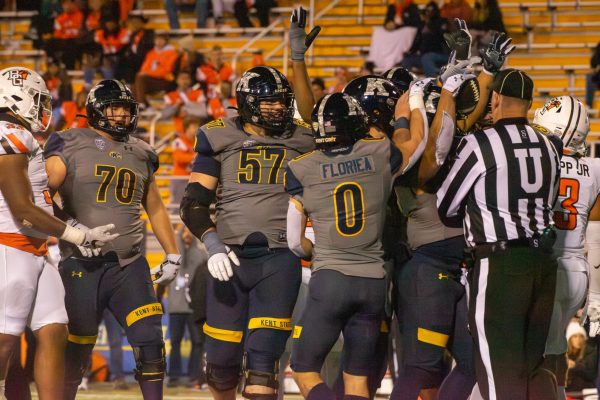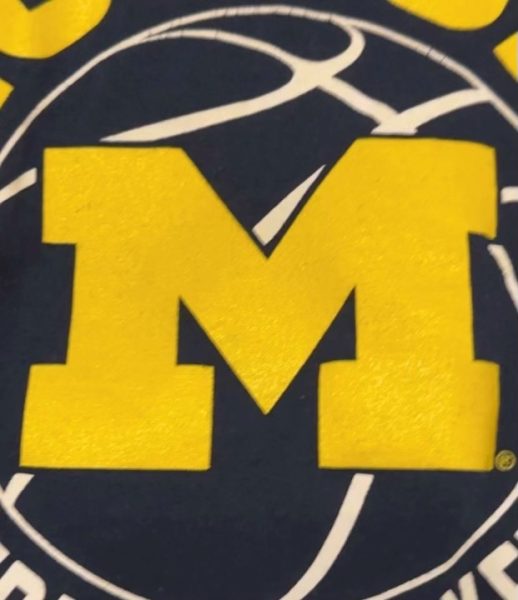Meet the architect behind Kent State football’s resurrection
May 11, 2020
Steven Schrum sat in his room in Reisterstown, Maryland, surrounded by miniature model professional stadiums, tinkering with his Madden 2001 lineup. With a PlayStation controller in hand, Schrum served as the architect of his favorite team — the St. Louis Rams.
He felt a certain level of pride in building the perfect lineup with his favorite childhood team.
He trained his brain to understand the nuances of football because his parents said he was too small to play. Instead, he played soccer.
When Schrum was 9-years-old, his dad sat him down to talk about his interest in football.
“Hey, why don’t you join our survival league?” he asked. “I’ll even pay the $25 entry fee.”
“Sure, I’ll join,” Schrum said, recruiting his friend, Jason Bloom, to play alongside him.
Each person picked a team to win every week, and after that week, they couldn’t pick that team again for the remainder of the season. Schrum and Bloom won the league, pocketing $4,000.
Schrum loved gaining a greater understanding of football, but his focus remained on soccer. He played in three leagues and honed his skills as a striker.
Before his junior season at The Boys Latin School in Baltimore, his mind shifted away from soccer. He began bugging the football coach, Ritchie Schell, for an opportunity to help the team as a scout.
Schell told him he’d think about it.
Schrum continued to pry, approaching him 20 more times, receiving the same answer. A few weeks later, Schrum approached Schell, who was sitting alone at a lunch table.
“Coach, I want to work in football,” he said. “I want to be a scout.”
After some in-depth questions, Schell relinquished and allowed Schrum to help.
In his first season with the team, he managed equipment and recorded stats.
His peers questioned his involvement with the program.
“What’re you crazy?” they said. “You don’t know football. You’ve never played football so you can’t know the game.”
He spent hours after school absorbing knowledge from the coaches. He was in the football offices just as much, if not more, than the players.
His hard work paid off heading into his senior year, as Schell allowed him to write scouting reports about opposing teams’ offenses and defenses. He gained the respect of his peers and the coaching staff.
The coaches gave Schrum CDs, which contained footage of opposing teams. He went home and inserted the discs into his PlayStation 2. He analyzed the tapes with the same controller he used to play Madden throughout high school.
A few weeks into the season, he was at his friend Michael’s house. He was the son of Baltimore Ravens’ general manager Ozzie Newsome. Schrum and Michael played Madden and NBA2K. A few hours later, Schrum left, not realizing he forgot some of his scouting reports on the kitchen table.
Michael showed Ozzie the reports, without Schrum’s knowledge. Michael told Schrum what he’d done later at school. He knew Schrum’s interest in gaining football experience.
For good measure, Schell asked senior vice president of football administration Pat Moriarty, whose son also went to Boys Latin, if Schrum could work with the Ravens for his senior project.
Moriarty said yes.
Schrum was excited about the opportunity, but he was still unsure which college he would attend.
A few weeks later, Schell pulled Schrum out of class.
“There’s someone I’d like you to meet,” he said. “This is coach James Franklin. He’s the wide receivers coach at Maryland. He’s here on a recruiting visit for Marco Jones.”
Schrum and Franklin shook hands, and Franklin gave him his business card.
After they met, Schell called Franklin.
“How can Schrum help with the team?” he asked.
“He can work as an equipment manger,” Franklin said.
After their conversation and a brief interview, Schrum secured the position at Maryland.
A few weeks later, The Boys Latin School football team finished 10-1, losing in the state championship game.
A few months later, Schrum and Michael started their senior year project through a program with the Ravens. They ordered the depth chart of each team based on salary and years remaining on their contract.
Schrum completed the program and later that summer left for the University of Maryland.
Maryland had a quality season, earning them a trip to the 2010 Military Bowl against East Carolina.
During a practice leading up to the game, Schrum set up the equipment for the running backs to use in drills.
“Hey, what’s the time?” Franklin, now offensive coordinator, asked.
Schrum told him, and 10 minutes later, Franklin left practice.
A few weeks later, on Dec. 17, 2010, Franklin took the head coaching job at Vanderbilt. Schrum was in disbelief, as the Maryland football program began to move in a different direction.
On Dec. 29, 2010, Schrum got up at 6 a.m. to get ready for the Military Bowl against Eastern Carolina. He went to the football facility to prep the equipment for the 10-minute bus ride to RFK Stadium.
“This is probably the last time you guys are going to eat,” Ron Ohringer, the head equipment manager, said in the team hotel before they ate breakfast.
Schrum didn’t eat again until 11 p.m. on the bus after the 51-21 win.
After a 9-4 season, head coach Ralph Friedgen was fired. Maryland hired Randy Edsall to replace him.
Schrum continued to ask for opportunities, but they came at a slower rate.
That is, until later that season when Maryland played against Notre Dame. Two quarterback injuries left them without a backup quarterback to perform the offensive signals, Schrum asked if he could do it.
For the next three weeks, he stood in front of the mirror in his apartment practicing the signals. He would come into Maryland’s football offices every day asking anyone who would listen to watch his signals to make sure they were game-ready.
On Nov. 12, 2011, Maryland played Notre Dame at FedEx Field. Schrum signaled the entire game accurately, as Maryland lost 45-21.
Despite the newfound opportunity to signal, Schrum knew he wanted more. He continued to ask for opportunities, but he was denied.
Eventually, he knew he needed a change.
He had two options: Florida with former Maryland graduate assistant Bush Hamdan or Vanderbilt with former Maryland offensive coordinator James Franklin.
He called Hamdan. After a few calls, Hamdan answered his phone.
“You have to get into school first,” Hamdan said. “When you get into school, give me a call.”
He applied to both. Soon after, he learned he was put on a waitlist at Vanderbilt, and his application to Florida had been accepted. Schrum called Hamdan.
“Hey Bush, I got into school,” Schrum said. “I’d like to come for a visit and get this thing rolling.”
A few weeks later, Schrum met with Hamdan and the video coordinator Reuel Joaqin to get him ready to help with the team.
“Is there anything I can do to help?” Schrum repeatedly asked.
Hamdan allowed Schrum to break down film. He did that for his first few weeks. One day, he was sitting in the offensive staff room talking with the coaches. Suddenly, the lights turned off.
“You can stay and watch film with us,” offensive coordinator Brent Pease said.
Schrum couldn’t believe it. He sat and absorbed as much information as he could.
On Dec. 3, 2012, Florida hired Joker Phillips as wide receivers coach and recruiting coordinator, replacing Hamdan.
Pease and Phillips gave Schrum a larger role. Pease allowed Schrum to create scouting reports for the offense, while Phillips promoted Schrum to be the assistant to the wide receivers coach.
Amid recruiting violations Phillips resigned in June 2014, and Schrum graduated yearning for his next opportunity.
Within a few months of graduation, he was working as an intern with the Ravens for the second time. He spent 115 hours in their facilities every week, asking questions and organizing their scouting database.
As the summer came to a close, Schrum asked if there were any openings. They told him no.
After the summer, Schrum called former Maryland student assistant Tyler Bowen, who’d taken a job at Towson.
“Hey, can you help me get on at Towson?” Schrum asked.
Bowen said he’d put a word in with the running backs coach Reno Ferri.
After Bowen’s conversation with Ferri, Schrum got an opportunity at Towson. On his first day, he walked into a cramped office, greeted by Ferri.
“What do you want to do?” Ferri asked. “Do you understand you’re volunteering your time?”
“Yes, this is what I want to do with my life,” Schrum said.
He and Ferri worked in the same small office. He would return from recruiting trips and have weekend recaps with Schrum about the experience.
“What have you learned?” Ferri would always ask.
Schrum would always find an answer.
After the season, he applied for a recruiting assistant job at Northwestern. He received the job, again working as a volunteer.
He screened prospects and passed the footage along to coaches to watch. He worked for 15 months, as his peers began to receive full-time, paying opportunities. He asked Northwestern if they had room on their staff.
They said they didn’t.
Schrum entered the second-floor of the house he rented with his girlfriend, Ronesha . He walked into his bedroom and laid with his feet hanging off his twin-size air mattress, thinking.
“Is this really what I want to do?” he asked himself.
Schrum thought back to a conversation he had with his parents before he left for Maryland.
“We’re gonna let you chase your dreams, and we believe in you,” Schrum’s parents told him. “You put a lot of work into chasing your goal.”
He knew he had their continued support — both emotionally and financially. He just needed any opportunity.
In February, Schrum went to Lou Malnati’s Pizza in Chicago with Ferri, who now worked as the tight ends/inside receivers coach at Syracuse. The two sat in Ferri’s car discussing future plans.
“If you hear of anything at Syracuse, I’d love to join you,” Schrum said.
Ferri didn’t respond.
A few months later, Schrum accepted the assistant recruiting coordinator job at Akron, his first paying job in football. He earned $6,000 a year.
A month later, Ferri texted him.
“Would you still be interested if a job opened up at Syracuse?” he asked.
“Absolutely!” Schrum said.
Two months later, Schrum was officially offered the recruiting quality control assistant position at Syracuse. He approached the Akron coaching staff, and they were supportive of his decision to leave.
Midway through the season, Schrum left for Syracuse.
In one of his first months there, Schrum checked Twitter and saw an offensive lineman named Alex Palczewski received an offer from Illinois.
“Who the heck is this kid?” Schrum thought to himself.
Palczewski had no other offers or junior year highlight tape. Schrum found Palczewski’s senior game tape and watched. Within 20 seconds, he paused the video and called co-offensive coordinator Sean Lewis, who was on the recruiting trail.
“Coach, this kid is ridiculously good,” Schrum said. “You have to go by his school.”
Lewis said he would check it out.
Palczewski had no junior year footage because of an injury. Lewis convinced him to come on an official visit, but ultimately, he decided to go to Illinois. He started as a true freshman.
A year later, Lewis turned around, away from the group of offensive coaches in a meeting.
“Hey, Schrum, I need to talk to you after this meeting in my office,” he said.
Schrum nervously walked into his office.
“Schrum, I’m interviewing for a job at Kent State,” Lewis said. “Would you be interested in being my director of player personnel?”
“Absolutely. Keep me updated,” Schrum said.
Two weeks later, Schrum was at LongHorn Steakhouse with his girlfriend when Lewis texted him.
“I’m a finalist for the Kent State job,” Lewis said. “We have to start working on my presentation.”
Schrum and Lewis worked on the presentation during an official visit.
Weeks later, Lewis came to Kent for his presentation. He returned the next day, and Schrum impatiently waited for the news.
He paced on the second floor of the offices, waiting to hear about a new opportunity. He sat down to try to tame his excitement.
Lewis emerged from his office.
“I got the job,” Lewis said. “Let’s get to work.”
Syracuse allowed Schrum and Lewis to build their Kent State roster for the next few weeks in the Syracuse offices.
In December, they left for Kent State. Schrum and Lewis spent their first few days as the only members of the new Kent State staff rearranging the office to be more appealing for recruits.
As Lewis scrambled to put together his coaching staff, Schrum focused on adding players. He scoured Twitter. Both Lewis and Schrum spent parts of Christmas and New Year’s in the football offices.
Over the next two months, Schrum helped secure 23 players, as Kent State improved from last in the Mid-American Conference to fifth.
Although those recruits had little immediate impact on the Flashes’ record. Schrum watched as Kent State lost four games by a combined 17 points, finishing 2-10.
“We’re going to get better,” Schrum told himself. “We just need a little time to turn it around.”
After securing the best recruiting class in program history, Schrum began to feel a change when he came to work.
Kent State started 3-3 after three losses to Power 5 opponents. They also beat Akron for the first time since 2014.
Following the win at Akron, Kent State lost three straight games by one possession.
On Nov. 14, 2019, Schrum paced the sideline as Kent State trailed Buffalo 27-6 with under eight minutes left. The Flashes were one loss away from losing bowl eligibility.
After cutting the lead to 27-13 with 7:39 left, Schrum watched as Kent State kicker Matthew Trickett recovered his own onside kick.
Schrum smiled.
“We’re gonna win this game,” he thought to himself.
Trickett made the 44-yard game-winning field goal as time expired, and Schrum watched as every player ran onto the field to celebrate. After two more wins, Kent State was bowl-eligible for the first time since 2011. The Flashes were going to play Utah State in the Tropical Smoothie Cafe Frisco Bowl in Frisco, Texas.
Schrum watched as Kent State beat Utah State, 51-41, for its first bowl win in school history.
As players dumped orange Gatorade on Lewis and ran towards midfield to celebrate, Schrum walked up the stairs into the stands. He gave his pass to Davis to get onto the field, and they walked to the far end zone to take in the celebration from afar.
On March 11, Kent State became the first FBS program to suspend its operations amid the COVID-19 pandemic.
Schrum’s daily duties remained the same, searching Twitter and Hudl for the next program-changing player on his 2012 MacBook.
Contact Ian Kreider at [email protected].


